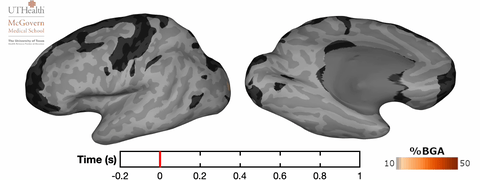Oscar Woolnough

Contact: oscar.woolnough@uth.tmc.edu
Research
My research utilises intracranial recordings to investigate the neural representations that underpin our ability to read. The high spatiotemporal resolution of intracranial recordings allows us to track the dynamic spread of information across the cortical surface, the interactions between multiple functional hubs, and the representation of the statistical properties of language that govern our reading speed. By using direct cortical stimulation through the same electrodes, we can also produce transient disruptions of function allowing a causal link to behavior.
 Spread of activation across the cortical surface while reading aloud [Source]
Spread of activation across the cortical surface while reading aloud [Source]
Visual Word Processing
To recognise a word we must convert from a combination of visual lines on the retina into an invariant representation of letters, and then link this to an object in our internal dictionary. This process is highly sensitive to the statistics of natural language, allowing easy access to high frequency words, and involves dynamic, recurrent feed-forward and feedback interactions within the visual stream. How do we determine whether a string of letters on a page relates to a word we know? How is information about commonly occuring words encoded into the word recognition process? How does the visual stream interact with the broader reading network to access the correct meaning and pronunciation and allow us to read aloud?
Sentence Comprehension
Reading a sentence requires an interface between the visual and language systems. The individual meanings and syntactic organisation of words when they are combined into phrases and sentences allows us to derive more complex meaning. How do we integrate information across these words to form higher meaning? How do we abstract out from the meanings of individual words to the meaning of an entire sentence? How do we build hierarchical structures from these word combinations?
Word Learning
Even as adults we constantly add new words into our vocabulary, meaning our reading network must be plastic to enable us to learn new visual word forms. What is the progression of neural changes that occur as we incorporate new words into our vocabulary? How do we create new associations between novel words and their sounds and meanings?



